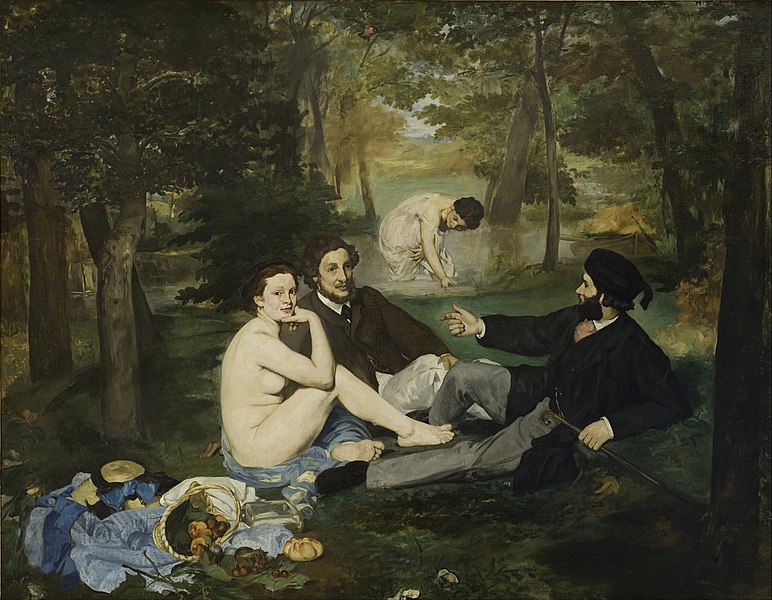Édouard Manet, Luncheon on the Grass
Édouard Manet (1832-1883) came from a Parisian bourgeois background, and he studied with the famous academician, Thomas Couture. His true masters were the painterly artists he copied at the Louvre – Hals, Titian, and the Spaniards Velázquez and Goya. He was a regular at the cafés, especially befriending Courbet, who was his role model. Like many Realist writers and artists, Manet was a flâneur, a social type that surfaced as early as the 1830s. The flâneur was an impeccably dressed man with perfect manners who kept abreast of current events through newspapers and gossip. His day was spent inconspicuously strolling the streets of Paris and acutely observing the fleeting moments of modern life, which he then translated into a painted or written image. The flâneur was witty and gregarious and delighted in shocking the bourgeois.

Out of this background Manet produced Luncheon on the Grass. The painting was rejected by the 1863 Salon jurors. But that year the jurors rejected a record number of artists, causing such a popular outcry that Louis Napoleon declared there would be a Salon des refusés (Salon of the Refused), an exhibition of the rejected artists to be held in conjunction with the official Salon of 1863.

The public showed up in record numbers to laugh at the rejects, and especially to view Manet’s Luncheon, which was front-page news in all the papers. Luncheon created a scandal by presenting a contemporary scene of a naked woman in a park with two nattily dressed men. It did not matter that critics acknowledged that the painting was inspired by the well-known fête champêtre in the Louvre, which similarly presented a nude seated with two dressed men. One writer even correctly recognized that the seated group exactly replicates the poses of river gods in a c. 1520 print by Marcantonio Raimondo after Raphael’s The Judgment of Paris. As far as the critics were concerned, referencing these august sources was not enough to overcome Manet’s flagrant lack of decorum.

What convinced the jurors and public that Manet was an incompetent sensationalist who deserved to be relegated to the Salon des refusés was his style. To their academically focused eye, he could neither model nor create convincing space. The picture looked like a preliminary sketch, not a finished picture. The figures are two-dimensional cutouts, flattened by their crisp, silhouetting contours and a flourish of broad brushstrokes that dispense with the halftones between dark and light needed to mold volume. A shadow indicating a fold on a pant’s leg, for example, is rendered with one bold, black sweep of the brush. The woman wading in the background is too large for her recessed location and seems to float directly over the seated group. All of the objects – figures, trees, the colorful still life of clothes and basket – hover in space, failing to connect and assemble into a coherent spatial structure. With Luncheon on the Grass, Manet began what twentieth-century critics would consider the modernist tradition, a tradition that emphasized the abstract qualities of art and that would continue for the next hundred years.[1]
- Penelope J.E. Davies, et. al. Janson’s History of Art: The Western Tradition, (Upper Saddle River, NJ: Pearson, 2007), 870-871. ↵

